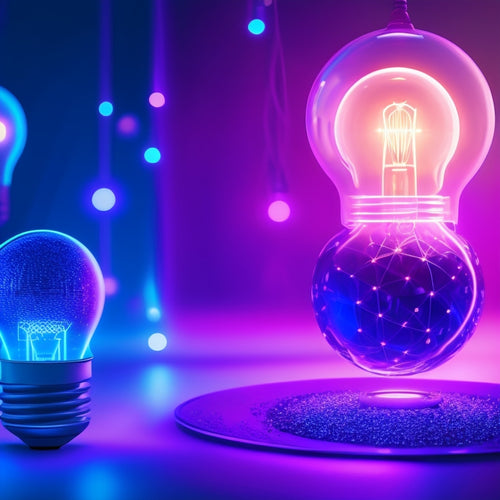
Mastering the Art of Organizing Thoughts
Share
You're constantly seeking ways to harness the chaos in your mind, unleash your full potential, and achieve a sense of control and clarity in your thoughts. To master the art of organizing your thoughts, start by compartmentalizing them, prioritizing actionable tasks, and incorporating mindful meditation into your daily routine. By doing so, you'll unleash efficiency, enhance cognitive function, and make informed decisions. As you work to overcome common obstacles like distractions and procrastination, you'll discover essential tools and resources to support your efforts. And, with consistent practice, you'll be able to tap into the power of organized thinking to achieve your goals - and that's just the beginning of your journey.
Key Takeaways
• Compartmentalize thoughts to reduce mental clutter and increase productivity by categorizing and prioritizing tasks and ideas.
• Incorporate mindful meditation and journaling to clarify thoughts, reduce stress, and enhance cognitive efficiency.
• Employ strategic planning and task management tools to streamline tasks, overcome procrastination, and create a sense of accomplishment.
• Identify and challenge negative thoughts through cognitive restructuring, and replace them with positive, actionable ones.
• Establish a daily routine that includes mindful reflection, journaling, and exercise to sustain mental organization and maintain focus.
Techniques for Mental Clarity
To achieve mental clarity, start by compartmentalizing your thoughts and prioritizing actionable tasks to help you stay focused and on track. This will enable you to tackle tasks one by one, reducing mental clutter and increasing productivity.
Next, try incorporating mindful meditation into your daily routine. This practice helps calm your mind, allowing you to think more clearly and make better decisions.
Additionally, thought journaling can be a powerful tool in achieving mental clarity. By writing down your thoughts, you can identify patterns, gain insights, and process your emotions.
The Power of Organized Thinking
By tapping into the power of organized thinking, you'll unlock a more efficient and productive version of yourself, capable of tackling complex tasks with clarity and confidence. This is achieved through cognitive efficiency, which enables you to process information quickly and make informed decisions.
Strategic planning also plays a key role, as it helps you prioritize tasks and allocate time effectively. Additionally, incorporating mindfulness practices into your daily routine can help you stay focused and mentally clear.
Cognitive restructuring, a technique used to challenge negative thoughts, can also contribute to a more organized mind. By adopting these habits, you'll be better equipped to manage your thoughts, reduce mental clutter, and achieve your goals.
Overcoming Common Obstacles
Identify the obstacles that hinder your ability to organize your thoughts, and tackle them head-on to break free from mental clutter and achieve clarity.
Managing distractions is key - prioritize tasks by focusing on the most important ones first. Learn to say no to non-essential tasks and set boundaries to protect your time.
Overcoming procrastination is also essential - break down large tasks into smaller, manageable chunks, and set realistic deadlines. By doing so, you'll create a sense of accomplishment and momentum.
Essential Tools and Resources
Moreover, you'll find a wide range of tools and resources available to help you organize your thoughts, from digital note-taking apps like Evernote and Simplenote to task management tools like Trello and Asana. These tools can help you streamline your thinking, prioritize tasks, and boost productivity.
Additionally, mind mapping software like MindMeister and Coggle can visually organize your ideas, making it easier to connect the dots and find patterns. Note-taking strategies, such as the Cornell Note-taking system, can also help you effectively capture and review information.
Moreover, task management apps like Todoist and Wunderlist can assist you in breaking down large projects into manageable tasks. By leveraging these tools and resources, you'll be better equipped to organize your thoughts, clarify your priorities, and achieve your goals.
Sustaining Mental Organization
Maintaining a mentally organized state requires consistent effort and intentional habits to keep your thoughts streamlined and focused.
To sustain mental organization, you'll need to make it a daily priority. Here are some habits to incorporate into your daily routines:
-
Practice mindful reflection to identify areas for cognitive declutter and emotional balance
-
Establish a consistent sleep schedule to regulate your mind and body
-
Set aside time for daily journaling to process your thoughts and emotions
- Engage in regular exercise to boost focus and productivity
Frequently Asked Questions
How Do I Handle Conflicting Priorities When Organizing My Thoughts?
"You're juggling a million priorities, but don't let them spin out of control! Use a Priority Matrix to visualize and weigh tasks, and leverage Time Management techniques to allocate your energy wisely, ensuring you're tackling the most critical ones first."
What if My Mind Dump Gets Too Overwhelming to Process?
When your mind dump feels overwhelming, don't panic! Break it down into smaller chunks, and prioritize tasks. Remember, information overload is normal - take a deep breath, and focus on gaining mental clarity by tackling one task at a time.
Can I Use Multiple Techniques Simultaneously for Better Results?
"You're probably thinking, 'the more techniques, the merrier, right?' Ironically, it's true! You can definitely use multiple techniques simultaneously, like mental mapping and journaling, a.k.a. technique layering, to create a personalized system that boosts your productivity and clarity."
How Do I Balance Organization With Spontaneity and Creativity?
You crave creative freedom, so don't let organization stifle your spontaneity. Instead, practice mindful flexibility by scheduling space for improvisation and embracing changes as they arise, allowing your thoughts to flow freely while still maintaining a sense of structure.
What if I Struggle to Maintain Motivation for Organizing My Thoughts?
As you navigate the ebb and flow of motivation, remember that consistent effort, not perfection, is key. Make a mindset shift towards habit formation, celebrating small wins, and you'll find your thoughts becoming clearer, more organized, and more manageable over time.
Related Posts
-

Transform Your Bathroom With Clever Storage Hacks
Elevate your bathroom's functionality and style with clever storage hacks. Maximize space by utilizing the back of th...
-

Lightware Academy Revolutionizes Pro AV E-Learning
Lightware Academy is revolutionizing Pro AV e-learning with its all-encompassing online platform, offering certified ...
-

Unleash Your Inner Artist With Watercolor Challenge
I'm taking the first step in awakening my inner artist by committing to a watercolor journey that will help me tap in...


